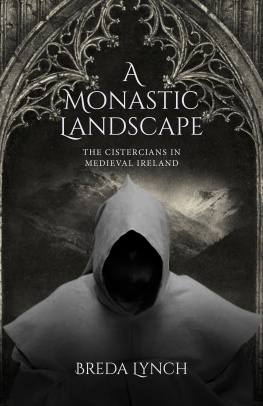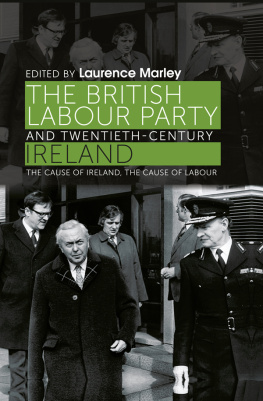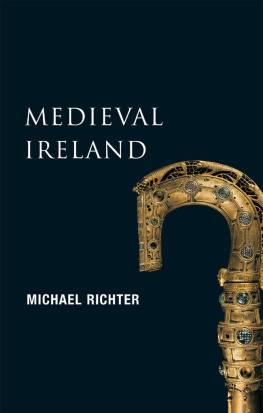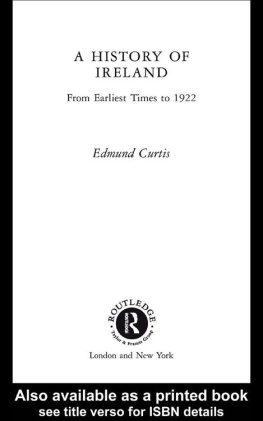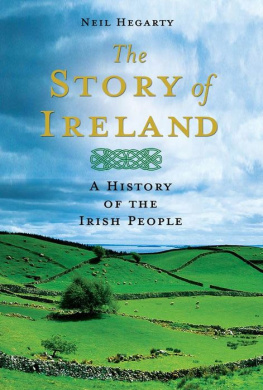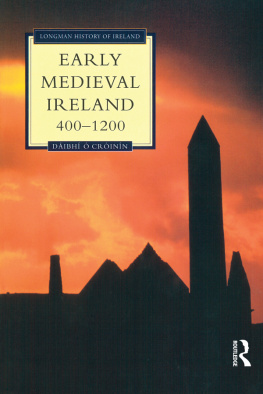
Copyright 2022 Breda Lynch
Paperback: 978-1-63767-357-7
Hardcover: 978-1-63767-397-3
eBook: 978-1-63767-358-4
Library of Congress Control Number: 2021915692
All rights reserved. No part of this publication may be reproduced, distributed, or transmitted in any form or by any electronic or mechanical means, without the prior written permission of the publisher, except in the case of brief quotations embodied in critical reviews and certain other noncommercial uses permitted by copyright law.
Ordering Information:

BookTrail Agency
8838 Sleepy Hollow Rd.
Kansas City, MO 64114
Printed in the United States of America
Contents
Dedication:

Abbreviations:
AC | Annals of Connacht, AD 1224-1544, ed. A.M. Freeman (Dublin, 1944, rear. 1996) |
AI | Annals of Inisfallen, ed. and trans. Sean Mac Airt (Dublin, 1951) |
Butler and Bernard, Duiske Charters |
Butler, Constance and Bernard, John, The charters of the Cistercian abbey of Duiske in the county of Kilkenny, RIA Proc., 35 C (1918-20) pp 1 - 188 |
Cal. docs. Ire. | Calendar of Documents Relating to Ireland, 1171-1307, ed. H. S. Sweetman (5 cols, London, 1875-86) |
Carrigan, Ossory | Carrigan, William, The history and antiquities of the dioceses of Ossory (4 vols, Dublin, 1905) |
Clyne, Kells Priory | Kells Priory, Co. Kilkenny: archaeological excavations by T. Fanning and M. Clyne (Archaeological Monograph series: 3, Department of the Environment, Heritage and Local Government, Dublin, 2007) |
I.H.S. | Irish Historical Studies |
Ir. Monastic possessions |
Extents of Irish monastic possessions, 1540-41, ed. N. B. White (Dublin, 1943) |
Irish Fiants of the Tudor Sovereigns |
Irish Fiants of the Tudor sovereigns during the reigns of Henry VIII, Edward VI, Philip & Mary, and Elizabeth I (4 vols, Edmund Burke, Dublin, 1994) |
J.R.S.A.I. | Journal of the Royal Society of Antiquaries of Ireland |
N.L.I. | National Library of Ireland |
O.K.R. | Old Kilkenny Review |
Ormond Deeds | Calendar of Ormond Deeds, ed. Edmund Curtis (6 vols, Dublin, 1932-43) |
R.I.A. Proc. | Proceedings of the Royal Irish Academy |
Statuta | Statuta Capitulorum Generalium Ordinis Cisterciensis, ed. Joseph Canivez (8 vols, Louvain, 1933-41) |
Townland index | General alphabetical index to the town lands and towns, parishes and baronies of Ireland (Dublin, 1861, rep., Baltimore, MD, 1955) |
M y motivation in writing this book is simple. Through the following pages I want to open up the fascinating world of the medieval monastery to you. I want to share knowledge, ignite your imagination and curiosity and help you to visualise these buildings not as old ruins but as the vibrant, colourful and peaceful places they once were.
Throughout this book we will explore the world of medieval Ireland from various aspects including the natural, political, religious and economic. Irish Christianity is a deeply culturally emotive subject. The physical remnants of this time are synonymous with the image of Ireland, from ruined monasteries, to round towers, high crosses and illuminated manuscripts and the treasures of early Christian Ireland created by gold and silversmiths of the first millennium. The uniqueness of the character of those early hermits permeates the Irish psyche to this day. The location of the country as a small island on the fringe of the known world allowed it to develop its own unique identity; one which is still evident today.
Questions direct conversation and this is true also of questions about a site or a religious order. In my experience the most often asked questions relate to the presence of artistic expression within a Cistercian monastery, the definition of abbey versus monastery, the status of abbot versus prior and the use of various rooms within the abbey plus general queries regarding the lives of the monks and the social world which surrounded the monasteries. Many people do not realise the existence of the complex or the purpose of the surrounding lands and estate. The notion of the monks being wealthy but premised on the old phrase of asset rich cash poor is not generally understood. For many people the sight of large monasteries and the statement of the acreage associated with the monastery equals fabulous wealth. An assumption that is wildly inaccurate. The question of the status of lay-brothers is another oft asked question. The organisation of a monks day or year is another ponderable as is the international dimension of the Cistercian organisation. The breakdown of the use of the rooms within the monastery, its organisation with regard to functional use and the arrangement of the outer complex is worthy of discussion and will form the basis of two full chapters. The use and organisation of one monastery can be used as the basis of study or explanation of others as the Cistercians, conveniently, built to a well-known plan. That plan and an analysis of it will receive much attention both to aid in an understanding of the organisation of the monastery and the day to day life of the monks but also to enable visitors to the monasteries in their current physical state to enjoy a re-created experience; enabling them to step back in time. We will take a deeper look behind the high walls of the monastery and discover what it was like to live within these monasteries. I will answer questions such as: what did the monasteries look like, were they decorated, what did the monks do, how were they organised, what interaction did the monks have with the world outside the monastery, how did it all end?
In relation to the exploration of the lands identified and listed within this text it is important to note that, when studying the medieval period, there are no comprehensive lists, no easy to download full histories of these sites. The information available is piecemeal, often what has been presented as factual histories of sites for decades turns out, with a little digging, to be inaccurate. It is impossible to compile complete directories of the lands held by each monastery from foundation to dissolution, and further discover the fate of that land into the modern period. Within the following chapters the information presented is, as always intended, a basis to aid further research. With that in mind, additional and updated information will be included on the accompanying website and I would encourage you to engage and return to that source over time; treat it as additional chapters, waiting to be explored and populated - www.drbredalynch.com
The purpose of this book is twofold. One I wish to provide a basic starting point for those interested in the study of the Cistercian Order in medieval Ireland. This is not meant as a full history of the order nor does it claim to be. The basic information such as the number of monasteries founded, the founders and location of those monasteries in both the medieval and modern landscape might sound simple. However, its complication is evidenced in that fact that such a task has not been compiled or discussed in any detail in one singe published volume prior to the first edition of this publication. That publication stemmed from my PhD thesis and while the information is difficult to obtain and has many gaps and omissions those gaps prompt further study and act as a way to progress the vast area of study that is the role of the Cistercian order in medieval Ireland. In addition to identifying the monasteries, founder and location I also include details of land, rights and privileges granted to various foundations. In order to best emphasise the evolution of the social and political world of the medieval Ireland into which the Cistercians settled and progressed I pay particular attention to the monasteries located within the lordship of Leinster. Following the evolution of the administration of that territory and the broader societal changes the focus extends to the province of Leinster and the establishment of the counties within that area before finishing with an examination of the monasteries and associated lands at time of the dissolution of the monasteries in the sixteenth century.
Next page
